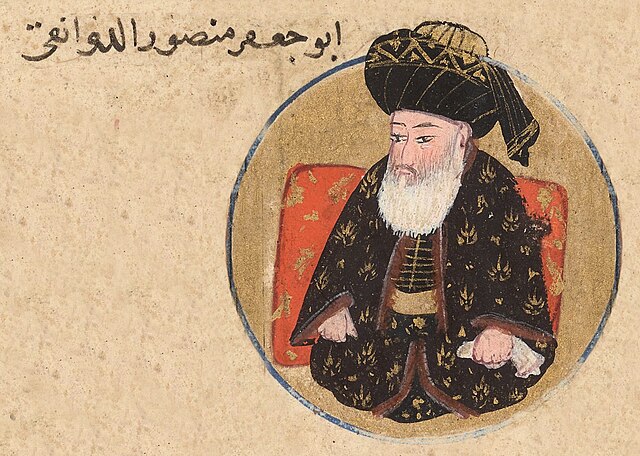The office of amir al-umara, variously rendered in English as emir of emirs, prince of princes, chief emir, and commander of commanders, was a senior military position in the 10th-century Abbasid Caliphate, whose holders in the decade after 936 came to supersede the civilian bureaucracy under the vizier and become effective regents, relegating the Abbasid caliphs to a purely ceremonial role. The office then formed the basis for the Buyid control over the Abbasid caliphs and over Iraq until the mid-11th century.
Silver dirham of 940/941 CE, with the names of Caliph al-Muttaqi and the amir al-umara Bajkam
The Abbasid Caliphate or Abbasid Empire was the third caliphate to succeed the Islamic prophet Muhammad. It was founded by a dynasty descended from Muhammad's uncle, Abbas ibn Abd al-Muttalib, from whom the dynasty takes its name. They ruled as caliphs for most of the caliphate from their capital in Baghdad in modern-day Iraq, after having overthrown the Umayyad Caliphate in the Abbasid Revolution of 750 CE (132 AH). The Abbasid Revolution had its origins and first successes in the easterly region of Khorasan, far from the bases of Umayyad power in Syria and Iraq. The Abbasid Caliphate first centered its government in Kufa, modern-day Iraq, but in 762 the caliph Al-Mansur founded the city of Baghdad, near the ancient Babylonian capital city of Babylon and Persian city of Ctesiphon. Baghdad became the center of science, culture, and invention in what became known as the Golden Age of Islam. It was also during this period that Islamic manuscript production reached its height. Between the 8th and 10th centuries, Abbasid artisans pioneered and perfected manuscript techniques that became standards of the practice. This, in addition to housing several key academic institutions, including the House of Wisdom, as well as a multiethnic and multi-religious environment, garnered it an international reputation as the "Centre of Learning".

Portrait of al-Mansur (r. 754–775) from the genealogy (silsilanāma) "Cream of Histories" (Zübdet-üt Tevarih, 1598)
Early 14th century copy of the Samanid-period Tarikhnama of Bal'ami (10th century) depicting al-Saffah (r. 750–754) as he receives pledges of allegiance in Kufa
Decorated niche from the Abbasid mosque of Afrasiab, Samarkand in Sogdia, 750–825 CE.
The spiral minaret of the Great Mosque of Samarra, built in 851 CE (237 AH) on the western side of the city of Samarra





